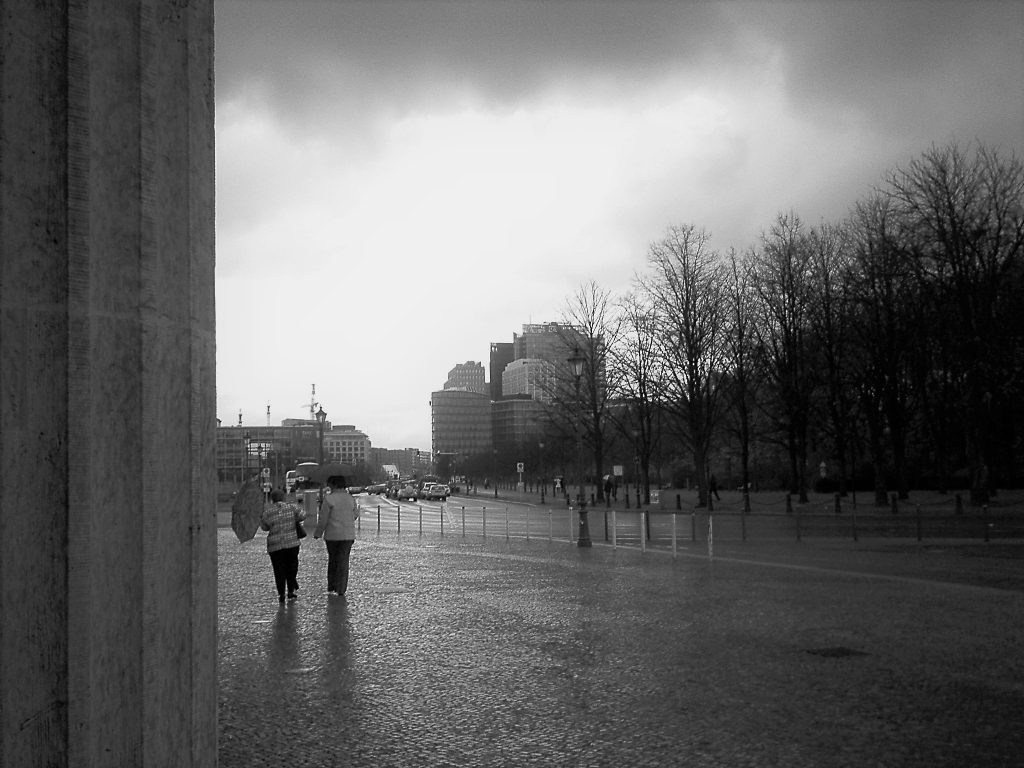by Umberto Pagano, exclusive for The diagonales –
IMPRINTING
Imprinting
My first, deep, contact with Berlin happened long before I physically went there, through the images of a movie which, for various reasons, ended up marking an era and a generation in particular, mine.
The sky above Berlin [1] was released in 1987, two years before that ’89 that shocked the world when that historical-concrete absurdity, which was called at the time of its building (1961) – with a lexical solution worthy of the best examples of Orwellian Newspeak – “Antifaschistischer Schutzwall” (Anti-Fascist Protection Rampart) finally fell. And by chance it becomes, in addition to the profound reflection on human nature it represents, also a vigorous visual document of “pre-fall” Berlin, one of the last, certainly the most aesthetically fascinating one.
In 1987 I was fourteen and Wenders’ black and white images of Berlin represented a sort of imprinting for me. From then on, Berlin has always remained a black and white city in my mind. As soon as I was eighteen, Berlin was the first European capital I visited. I found myself skirting the long stretches of wall still standing and picturing one by one the old cult murals on the West side and the very recent ones on the East side.
Imprinting. I can’t stay in Berlin without seeing it through the eyes of Wenders’ angels, in black and white indeed, without photographing its clouds, without thinking to mayself of Handke’s magnetic words from the beginning of the movie. Perhaps only today, with a retrospective look, I do realize that, after all, the questions contained in those words have been “die Grundlage” (the foundation) of my personal and professional experience:
(…)
When the child was a child,
It was the time for these questions:
Why am I me, and why not you?
Why am I here, and why not there?
When did time begin, and where does space end?
Is life under the sun not just a dream?
Is what I see and hear and smell
not just an illusion of a world before the world?
Given the facts of evil and people.
does evil really exist?
How can it be that I, who I am,
didn’t exist before I came to be,
and that, someday, I, who I am,
will no longer be who I am?
[1] The horrible English title is “Wings of Desire”.

IMPRINTING
Il mio primo contatto profondo con Berlino è avvenuto prima che ci andassi fisicamente, attraverso le immagini di un film che, per vari motivi, ha finito per segnare un’epoca e una generazione in particolare, la mia.
Il cielo sopra Berlino, uscì nel 1987, due anni prima di quel ’89 che sconvolse il mondo e in cui cadeva quell’assurdità storico-cementizia che, alla sua edificazione nel 1961, fu denominato “Antifaschistischer Schutzwall” (Barriera di protezione antifascista), con una soluzione lessicale degna dei migliori esempi della “neolingua” orwelliana. E per caso diventa, oltre che la profonda riflessione sull’uomo che rappresenta, anche un documento visivo di rara forza della Berlino “pre-caduta”, uno degli ultimi, sicuramente quello esteticamente più affascinante.
Nel 1987 avevo quattordici anni e le immagini bianco e nero della Berlino di Wenders rappresentarono per me una sorta di imprinting. Da allora in poi, nella mia mente Berlino è sempre rimasta una città in bianco e nero. A 18 anni Berlino fu la prima capitale europea che visitai. Mi ritrovai a costeggiare i lunghi tratti di muro ancora in piedi e a fotografare uno ad uno i murales, ormai cult, del lato ovest e quelli allora recentissimi del lato Est.
Imprinting. Non riesco a stare Berlino senza vederla con gli occhi degli angeli di Wenders, in bianco e nero appunto, senza fotografare le sue nuvole, senza ripassare a mente le magnetiche parole di Peter Handke con cui si apre il film. Forse solo oggi, con sguardo retrospettivo, mi rendo conto che, in fondo, quelle domande sono state “die Grundlage” (il fondamento) della mia esperienza personale e professionale:
(…)
Quando il bambino era bambino,
era l’epoca di queste domande:
Perché io sono io, e perché non sei tu?
Perché sono qui, e perché non sono lì?
Quando comincia il tempo, e dove finisce lo spazio?
La vita sotto il sole è forse solo un sogno?
Non è solo l’apparenza di un mondo davanti al mondo quello che vedo, sento e odoro?
C’è veramente il male e gente veramente cattiva?
Come può essere che io, che sono io,
non c’ero prima di diventare,
e che, una volta, io, che sono io,
non sarò più quello che sono?

Umberto Pagano insegna “Sociologia della Cultura” presso l’Università “Magna Graecia” di Catanzaro. E’ tremendamente appassionato di Bach. Ha 47 anni, una moglie, due figli e tre pesci rossi. Non ama essere fotografato.
La sua ombra si.





